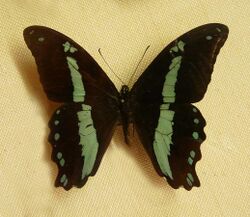Biology:Papilio sosia
| Medium green-banded swallowtail | |
|---|---|

| |
| Specimen on display in Musée zoologique de la ville de Strasbourg | |
| Scientific classification | |
| Domain: | Eukaryota |
| Kingdom: | Animalia |
| Phylum: | Arthropoda |
| Class: | Insecta |
| Order: | Lepidoptera |
| Family: | Papilionidae |
| Genus: | Papilio |
| Species: | P. sosia
|
| Binomial name | |
| Papilio sosia | |
| Synonyms | |
| |
Papilio sosia, the medium green-banded swallowtail, is a butterfly of the family Papilionidae. It is found in the Afrotropical realm. The species was first described by Walter Rothschild in 1903.
Description
Forewing above in cellules 1 b—8 with distinct, small, usually double submarginal dots, but beneath without large submarginal spots; the median band formed almost as in nireus, though the spot in cellule 2 covers the base of the cellule, but is more produced anally than the spot in 1 c, which does not reach the cell. — Sierra Leone to the Congo region and Uganda.[4] The median band is straight and regular and never less than 1 cm in cell lb of the forewing, nearly always much wider.
Biology
The larva feeds on Zanthoxylum and Citrus.
Subspecies
Subspecies include:
- P. s. sosia (Guinea, Sierra Leone, Liberia, Ivory Coast, Ghana, Togo, Benin, southern Nigeria, western Cameroon)
- P. s. pulchra Berger, 1950 [5](Cameroon, Gabon, Congo, Central African Republic, northern Angola, Congo Republic)
- P. s. debilis Storace, 1951 [6] (Uganda, northwestern Tanzania)
Taxonomy
Papilio sosia belongs to a clade called the nireus species group with 15 members. The pattern is black with green or blue bands and spots and the butterflies, although called swallowtails, they lack tails with the exception of Papilio charopus and Papilio hornimani. The clade members are:
- Papilio aristophontes Oberthür, 1897
- Papilio nireus Linnaeus, 1758
- Papilio charopus Westwood, 1843
- Papilio chitondensis de Sousa & Fernandes, 1966
- Papilio chrapkowskii Suffert, 1904
- Papilio chrapkowskoides Storace, 1952
- Papilio desmondi van Someren, 1939
- Papilio hornimani Distant, 1879
- Papilio interjectana Vane-Wright, 1995
- Papilio manlius Fabricius, 1798
- Papilio microps Storace, 1951
- Papilio sosia Rothschild & Jordan, 1903
- Papilio thuraui Karsch, 1900
- Papilio ufipa Carcasson, 1961
- Papilio wilsoni Rothschild, 1926
See also
- Congolian forests
- Guinean Forests of West Africa
References
- ↑ Rothschild, W., & Jordan, K. 1903 Some new African Papilios. Novitates Zoologicae 10: 488-490.
- ↑ "Afrotropical Butterflies: File C – Papilionidae - Tribe Papilionini". http://atbutterflies.com/downloads/papilionidae_papilionini.doc.
- ↑ Savela, Markku. "Papilio sosia Rothschild & Jordan, 1903". http://www.nic.funet.fi/pub/sci/bio/life/insecta/lepidoptera/ditrysia/papilionoidea/papilionidae/papilioninae/papilio/#sosia.
- ↑ Aurivillius, [P.O.]C. 1908-1924. In: Seitz, A. Die Großschmetterlinge der Erde Band 13: Abt. 2, Die exotischen Großschmetterlinge, Die afrikanischen Tagfalter, 1925, 613 Seiten, 80 Tafeln (The Macrolepidoptera of the World 13).Alfred Kernen Verlag, Stuttgart.
 This article incorporates text from this source, which is in the public domain.
This article incorporates text from this source, which is in the public domain.
- ↑ Berger, Lucien A., 1950 Catalogues raisonnes de la faune entomologique du Congo Beige.Lepidopteres-Rhopaloceres. I.-Fam. Papilionida:" [in French). Ann. Mus. Congo Belge C. Zool. Serie III (II), voJ.8: pp.1-L04, 96 figs. 1950.
- ↑ Storace, L. (1951-1952). Recherches sur le groupe africain de Papilio nireus L. Lambillionea 51:44-52; 54-57; 73-76.
Sources
- Carcasson, R.H. (1960). "The Swallowtail Butterflies of East Africa (Lepidoptera, Papilionidae)". Journal of the East Africa Natural History Society pdf Key to East Africa members of the species group, diagnostic and other notes and figures. (Permission to host granted by The East Africa Natural History Society)
- Collins, N. Mark; Morris, Michael G. (1985). Threatened Swallowtail Butterflies of the World: The IUCN Red Data Book. Gland & Cambridge: IUCN. ISBN 978-2-88032-603-6. https://www.biodiversitylibrary.org/item/98674#page/7/mode/1up.
- Larsen, T.B. (2005). Butterflies of West Africa Apollo Books ISBN:87-88757-43-9
- Storace, L. (1951-1952). Recherches sur le groupe africain de Papilio nireus L. Lambillionea 51:44-52; 54-57; 73-76.
External links
| Wikimedia Commons has media related to Papilio sosia. |
- Butterfly Corner Images from Naturhistorisches Museum Wien
Wikidata ☰ Q7132967 entry
 |

